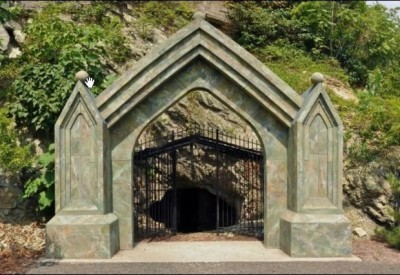
THE MILE SCARED: Haunted Hoboken’s Harrowing History of Murder, Mayhem and Melancholia
Generally I’m a skeptical person—I believe the Loch Ness Monster is a well-fed cormorant, I believe the Chupacabra is a coyote with mange and I’m pretty certain most Sasquatch sightings are the product of bored mountain men with beer. Having said that, I also firmly believe that my house is haunted.
The events in my home go beyond typical “things that go bump in the night.” Every now and then I’ll see things out of the corner of my eye. Things that I know I had placed somewhere go missing, only to reappear in that very spot months later. I’ve even awoken to the sensation of a physical presence pushing down on me, forcing me to bolt upright in bed and gasp for air. While these could be easily chalked up to the onset of dementia and acid reflux, the clincher (cue spooky music) came when my 3-year old calmly announced one day that there was, “a ghost sitting in that chair—her name is Gretchen.”
I had no reason to doubt him, since I had an inkling myself prior to his unprompted disclosure. Meanwhile, it has been said—by those who believe enough to say these things—that children have a heightened sense of awareness when it comes to the supernatural. Throw in the somewhat obscure choice of name, in keeping with Hoboken’s rich German immigrant heritage, and a solid case is being established. Given my child’s casual approach to the matter, I decided not to be bothered by Gretchen—so long as she keeps her interactions lighthearted and cuts back on those “Danny Torrance from The Shining” moments with my boy. She has obliged, and now we all get along just fine.
We are not alone
I know others in town who aren’t so lucky. One neighbor (name withheld) recounted a tale of a malevolent old woman who haunted her home, occupying one particularly chilly corner of her hallway. Guests often noticed and commented on how uneasy that spot made them feel. Meanwhile my neighbor had developed an uncharacteristic obsession with cleanliness and the removal of shoes in the apartment. Someone living nearby soon disclosed that a previous occupant was an overbearing mother who was infamous throughout the neighborhood for compulsive cleaning. Eventually work was done on the apartment, and in the process the contractors uncovered an old Ouija board and an even more puzzling set of pig’s bones within the walls of the building. After removing those items, the presence was gone.
Yet another neighbor was so tormented by the sinister presence in his home that he found himself in the basement one day having a shouting match with the “thing.” That’s where it gets truly spooky—and while this all makes for great late night cable TV fodder, its compelling stuff that’s happening in our condos or the apartment next door. Typically when one hears of “haunted houses,” the images of rural farms or ancient castles immediately come to mind. But while the horns and sirens of an urban environment may do well to mask the spiritual presence, that doesn’t mean it’s not there.
Voices from the past
If you think Hoboken today is physically crowded, just imagine how packed it must be metaphysically. Centuries, if not millennia of inhabitants have left their mark on our city, and it’s not beyond the realm of possibility that some continue to do so…

Common Type of Native Burial in Earlier Times
From “The Lenape-Delaware Indian Heritage”
By Herbert C Kraft.
Prior to the arrival of Europeans, the indigenous Lenni Lenape populated an area that stretched from the Lower Hudson Valley on down through Delaware. Generally speaking, the life expectancy of Native Americans was around 35 years of age. Meanwhile, child mortality among the Lenape was so prevalent that children were not given a formal name until they were around three years old. According to the New Jersey Historical Commission’s “Lenape Lifeways” (lenapelifeways.org):
The dead were laid in a shallow grave lined with tree bark or grass mats. In early times, the arms of the dead person were folded across the chest. The knees were bent so that the legs were close to the body. Sometimes, a clay pot was filled with food and placed in the grave. This food gave the soul of the dead person strength to make the long journey to heaven.
The Lenape believed that the soul of good people went to live with the Great Creator Kishelemukong in the highest heaven, but the souls of evil individuals had to stay outside this “happy hunting ground“ forever.
Where these evil souls went is open for interpretation. Meanwhile, the arrival of European settlers brought conflict and pestilence that decimated the Lenape, and every other Native American tribe that inhabited the New World. As their wigwams were razed to make way for Brownstones, it’s likely that more than a few of these shallow graves were disturbed.
Edgar Allan Poe-boken?
As Hoboken grew, it became a destination for tourists from across the Hudson. One of the town’s main attractions was Sybil’s Cave—a manmade well at the bottom of Castle Point where thirsty hikers were sold “medicinal” water from the natural spring below. In July of 1841, the cave’s fame turned to infamy when the body of Mary Cecila Rogers was discovered offshore.
 Mary was 20 years old and by all accounts quite attractive. Her mother owned a boarding house and Mary worked in a tobacconist near Manhattan’s growing publishing district. Once editors, many of whom knew Mary personally, got wind of her gruesome demise, it was sensationalized on par with the juiciest tabloid murder mysteries of today. There was overwhelming evidence of foul play and the Hoboken coroner concluded that she died of strangulation, going as far as to disclose evidence of sexual assault. Weeks later, her blood-stained clothes were found in a wooded area near Weehawken.
Mary was 20 years old and by all accounts quite attractive. Her mother owned a boarding house and Mary worked in a tobacconist near Manhattan’s growing publishing district. Once editors, many of whom knew Mary personally, got wind of her gruesome demise, it was sensationalized on par with the juiciest tabloid murder mysteries of today. There was overwhelming evidence of foul play and the Hoboken coroner concluded that she died of strangulation, going as far as to disclose evidence of sexual assault. Weeks later, her blood-stained clothes were found in a wooded area near Weehawken.
Among the many suspects was Mary’s boyfriend, Donald Payne, who was also among the last to report seeing Mary alive. Others were accused, but the trial of public opinion had Payne branded as the killer. Yet the charges never stuck, and Mary’s murderer was never brought to justice.
Overcome by grief and public scrutiny, Payne himself returned to Sybil’s Cave, drank a bottle of poison and did himself in.
About a year later, an innkeeper confessed to dumping Mary’s body after a botched “medical procedure,” alluding to an abortion. The doctor had the innkeeper hide Mary’s clothing in the woods in an attempt to confuse investigators.
Among the many following this story was an underemployed writer by the name of Edgar Allan Poe. His “The Mystery of Marie Roget” is a dramatization of the Mary Rogers case—set in Paris, but based entirely on the events right here in Hoboken.
Falling to the flames
Like any densely populated metropolitan area, Hoboken has seen its share of tragedy in the form of fire. By far the most devastating was the Pier Fire of 1900, which burned for three days on the city’s waterfront, claiming three ships and over 300 lives. Also in 1900, a fire at First and Adams took the lives of 13. Other tragic fires include a blacksmith shop at Newark and Adams that killed three people in 1897, 13 more people perished in the 1921 Palace Hotel blaze on Newark Street, and a tenement house fire in 1967 claimed the lives of five while destroying the birthplace of Frank Sinatra at 415 Monroe Street.
That 1967 fire was the first of many fatal tenement fires in Hoboken. A 1973 arson fire took the lives of 11 tenement dwellers on 11th and Willow. This was followed by another arson at 131 Clinton which killed 21 in 1979. Eleven more died in 1981 as fire swept through 12th and Washington, while a year later 12 people were killed in a fire at Pinter’s Hotel on 14th Street. Fires continued as real estate values coincidentally skyrocketed, prompting widespread suspicion of organized crime activity and the forced displacement of lower income residents. In her film Delivered Vacant, director Nora Jacobson chronicles the all-too-often fatal gentrification battles of Hoboken’s dramatic redevelopment.
For more on Hoboken’s firefighting past and present, visit hobokenfire.org or stop by the Hoboken Fire Department Museum at 213 Bloomfield Street.
Permanent Regulars
With an epic reputation for dens of iniquity, there’s no surprise that some of Hoboken’s bars and taverns have supernatural patrons that simply won’t heed last call. Countless bartenders recount tales of being chased from the premises by forces unseen and hearing eerie whispers while restocking shelves afterhours.
Notably, Arthur’s Tavern (237 Washington Street) is said to be occupied by mischievous spirits that have been known to pull hair and hurl objects across the room. The upstairs in particular is cited as being a hotbed of paranormal activity, but only afterhours—patrons can still enjoy their massive steaks in peace.
The same goes for The Brass Rail (135 Washington Street), where guests can enjoy a sensational selection of food, wine and spirits—while the staff has been witness to spirits of their own. It is said that a wedding reception took place in the establishment in 1904, when the bride tripped and fell down the spiral staircase and broke her neck. Devastated, the groom then hung himself in the utility closet. Their spirits are said to still haunt the place—knocking over trays and even making the occasional appearance on the staircase. In fact, The Brass Rail has been known to see a bump in business around this time of year from paranormal enthusiasts who happen to enjoy a great meal, so be sure to get there early (before the witching hour).
Did we scare you out of town?
It’s not that “Haunted Hoboken” is particularly haunted, but like any place, it has a history. If you’d like to learn more about what may or may not have occurred in your building, swing by the Hoboken Public Library (500 Park Avenue) or the Hoboken Historical Museum (1301 Hudson Street) and see what you can dig up. Or if you’d rather just forget you ever read this, pull your blanket over your head and find your happy place, that could always work too.
-Originally published in the Sep/Oct 2011 issue of hMAG





 Previous Article
Previous Article Next Article
Next Article FREEDY RETURNS: Singer/songwriter Freedy Johnston found fame out of Hoboken in the 1990s—now he’s come back to his roots
FREEDY RETURNS: Singer/songwriter Freedy Johnston found fame out of Hoboken in the 1990s—now he’s come back to his roots  CATCH ‘EM WHILE YOU CAN: Area Talent Flocks to White Eagle Hall — FRIDAY, DECEMBER 1st
CATCH ‘EM WHILE YOU CAN: Area Talent Flocks to White Eagle Hall — FRIDAY, DECEMBER 1st  DOUBLE-DOWN: Substantial Fiscal Woes Come to Light in Hoboken
DOUBLE-DOWN: Substantial Fiscal Woes Come to Light in Hoboken  Hoboken’s NoVia (North of the Viaduct): Not Just Viable — Vivacious
Hoboken’s NoVia (North of the Viaduct): Not Just Viable — Vivacious  UGLY, EVEN FOR HOBOKEN: Six Months Since Forged Xenophobic Fliers Put Mile Square Politics Under Worldwide Scrutiny
UGLY, EVEN FOR HOBOKEN: Six Months Since Forged Xenophobic Fliers Put Mile Square Politics Under Worldwide Scrutiny  FEED IT FORWARD: Hoboken Chef Delivers Meals to American Legion Veterans, First Responders, Homeless Shelter & More
FEED IT FORWARD: Hoboken Chef Delivers Meals to American Legion Veterans, First Responders, Homeless Shelter & More  HIGH-END HOBOKEN: Luxury Real Estate on ‘The Gold Coast’ Gets More and More Polished
HIGH-END HOBOKEN: Luxury Real Estate on ‘The Gold Coast’ Gets More and More Polished  HO-BAKIN’, NJ—A Hard-Crusted Town With a Soft, Warm Center
HO-BAKIN’, NJ—A Hard-Crusted Town With a Soft, Warm Center